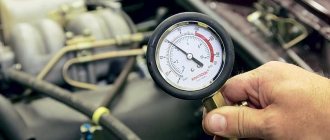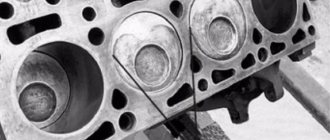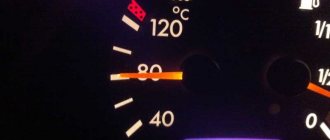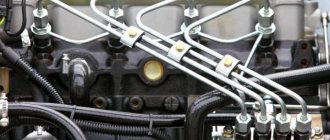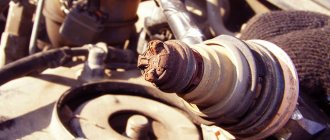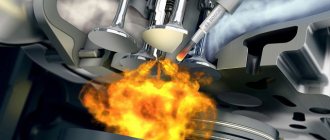It is known that the operating efficiency of an automobile internal combustion engine is directly dependent on the efficiency factor. Engine efficiency is expressed as the ratio of power transferred to the crankshaft and pistons. Modern internal combustion engines are more efficient than their outdated counterparts. For example, a 1.6 liter engine previously developed a power of no more than 70 horsepower, but now this parameter often reaches 150 hp. With.
Steam engine efficiency
To operate the power unit, it is necessary to convert the thermal energy generated by the combustion of the air-fuel mixture into mechanical energy. Previously, steam engines were used in which solid fuel (coal, firewood) was burned, the pistons were set in motion under the influence of expanding steam. The dimensions of such power plants were several times larger in size than modern engines running on other types of fuel.
In piston-type steam engines, the efficiency does not exceed 10%. Currently, such devices are almost never used, since it is believed that there are no fundamental ways to increase their efficiency.
In order to increase this indicator, heat sources with the lowest cost are used. For example, large thermal power plants use nuclear energy. In addition, modern technologies are used in which waste heat does not go uselessly into the atmosphere, but is used for heating systems in apartment buildings. The losses here are no more than 10 percent. Modern steam turbines have an efficiency coefficient of 50 - 60%.
Interesting: In developed European countries (Switzerland, Austria), steam locomotives are very popular. They are used as tourist transport for transporting passengers along mountain roads. Thanks to numerous improvements, the economic performance of steam locomotives often rivals both electric and diesel locomotives.
Energy value of diesel fuel and gasoline
Diesel fuel consists of heavier hydrocarbons than gasoline. The lower efficiency of a gasoline unit compared to a diesel engine also lies in the energy component of gasoline and the characteristics of its combustion. Complete combustion of equal amounts of diesel fuel and gasoline will produce more heat in the first case. Heat in a diesel internal combustion engine is more fully converted into useful mechanical energy. It turns out that when burning the same amount of fuel per unit of time, it is the diesel engine that will do more work.
It is also worth taking into account the features of injection and the creation of proper conditions for complete combustion of the mixture. In a diesel engine, fuel is supplied separately from the air; it is injected not into the intake manifold, but directly into the cylinder at the very end of the compression stroke. The result is a higher temperature and the most complete combustion of a portion of the working fuel-air mixture.
What determines the efficiency of a diesel engine?
If you compare the efficiency of gasoline and diesel engines, it turns out that the second one has the best performance:
- it has been observed that gasoline engines convert only one-fourth of the energy used into mechanical work;
- while diesel engines - 40%, respectively;
- When installing turbocharging in a diesel engine, the efficiency of a gas turbine engine increases to 50 percent or more.
The design and operating principle of diesel engines contribute to the greatest efficiency in comparison with carburetor engines. Reasons for better diesel engine efficiency:
- Higher compression ratio.
- Fuel ignition occurs according to a different principle.
- Body parts heat up less.
- Thanks to fewer valves, energy consumption to overcome friction forces is reduced.
- The design of a diesel engine does not include the usual spark plugs and ignition coils, which require additional energy from an electric generator.
- The diesel crankshaft spins at lower speeds.
Compared to diesel engines, electric engines are considered more efficient. The engine with the highest efficiency is electric. With the creation of more durable batteries that are not afraid of frost, the automotive industry will gradually switch to producing electric vehicles in large quantities.
Power and torque
With the same displacement, the power of a naturally aspirated gasoline engine is higher, but is achieved at higher speeds. The engine needs to be “turned”, losses increase, fuel consumption increases. It is also necessary to mention torque, which literally means the force that is transmitted from the engine to the wheels and moves the car. Gasoline internal combustion engines achieve maximum torque at higher speeds.
A similar naturally-aspirated diesel engine reaches peak torque at low speeds, while using less diesel fuel to do useful work, which means higher efficiency and fuel economy.
Diesel fuel generates more heat compared to gasoline, the combustion temperature of diesel fuel is higher, and the detonation resistance is higher. It turns out that a diesel internal combustion engine produces more useful work on a certain amount of fuel.
Summary
In the production of modern internal combustion engines, manufacturing plants invest heavily in the pursuit of increasing the efficiency of their products by at least a few percent. To this end, engineers are improving and complicating motor designs and using new materials to manufacture individual elements.
Sometimes it happens that the financial costs of developers are inappropriate, in comparison with the obtained result of 2 - 3%. Therefore, it may be more profitable to subject standard engines to various boosts, fine-tuning, and modifications using tuning improvements in small repair shops. As a result, the power and other traction characteristics of power units increase.
More about losses
Looking ahead, we can confidently say that the efficiency of a gasoline engine ranges from 20 to 25%. And there are many reasons for this. If we take the incoming fuel and convert it into percentages, then we seem to get “100% of the energy” that is transferred to the engine, and then there are losses:
1) Fuel efficiency . Not all the fuel is burned, a small part of it goes with the exhaust gases, at this level we already lose up to 25% efficiency. Of course, now fuel systems are improving, an injector has appeared, but it is far from ideal.
2) The second is thermal losses and . The engine warms itself and many other elements, such as radiators, its body, and the liquid that circulates in it. Also, some of the heat leaves with exhaust gases. All this results in up to 35% loss of efficiency.
3) The third is mechanical losses . ON all kinds of pistons, connecting rods, rings - all places where there is friction. This can also include losses from the load of the generator, for example, the more electricity the generator generates, the more it slows down the rotation of the crankshaft. Of course, lubricants have also made progress, but again, no one has yet been able to completely overcome friction - losses are still 20%.
Thus, the bottom line is that the efficiency is about 20%! Of course, among the gasoline options, there are standout options in which this figure is increased to 25%, but there are not many of them.
That is, if your car consumes fuel 10 liters per 100 km, then only 2 liters of them will go directly to work, and the rest are losses!
Of course, you can increase the power, for example, by boring the head, watch a short video.
If you remember the formula, it turns out:
This is interesting: Brake slave cylinder - how to prevent major troubles?
Thermal Cycle Analysis
The thermal cycle includes four thermodynamic basic processes. First, the state of the working fluid is transformed, and then it returns to its original state: compression, heat generation, expansion and heat removal.
Each of these processes is carried out according to the following scheme, which determines the conditions for the implementation of the cycle:
- Isothermal - work is performed at a constant temperature.
- Isobaric - the operating cycle is implemented at constant pressure.
- Isometric - the thermal process occurs at a constant volume
- Adiabatic - the cycle is carried out at constant entropy.
In order for the process to be as close to reversible as possible, there are two ways to move the piston: isothermal - this means that heat gradually enters or leaves the reservoir at a temperature infinitely different from the temperature of the gas in the piston, and adiabatic, in which no heat exchange occurs at all, the gas acts like a spring.
Thus, when heat is added and the gas expands, the temperature of the gas must remain the same as that of the heat source, with the gas expanding isothermally. Likewise, it will later be compressed in the cycle isothermally, releasing heat.
To find out efficiency, you need to follow the engine through its entire cycle, find out how long it runs, how much heat is taken from the fuel, and how much energy is lost in preparation for the next cycle.
The thermal cycle characteristics associated with a heat engine are typically described using two state diagrams : a PV diagram showing the pressure-volume relationship and a TS diagram showing the temperature-entropy pair.
For a constant mass of gas, the operation of a heat engine is a repeating cycle, and its PV diagram will look like a closed figure.
About diesel fuel efficiency
FROM a higher efficiency value, fuel efficiency follows. So, for example, a 1.6-liter engine can consume only 3–5 liters in the city, in contrast to the gasoline type, where the consumption is 7–12 liters. A diesel engine has much more torque, the engine itself is often more compact and lighter, and, recently, also more environmentally friendly. All these positive aspects are achieved thanks to a higher compression ratio; there is a direct relationship between efficiency and compression, see the small plate.
However, despite all the advantages, it also has many disadvantages.
As it becomes clear, the efficiency of an internal combustion engine is far from ideal, so the future clearly belongs to electric options - all that remains is to find efficient batteries that are not afraid of frost and hold a charge for a long time.
Read more: Replacing the window lifter mechanism of a VAZ 2107
I’ll finish here, read our AUTOBLOG.
( 26 votes, average: 4.08 out of 5)
Surely, many car enthusiasts have wondered how the power of an internal combustion engine corresponds to its utility. It is assumed that the higher the efficiency of a power system, the more efficient it is. Speaking in absolute terms, today the highest coefficient is for electric motors; in some models it reaches about 95 percent. As for internal combustion engines, for most of them, regardless of the type of fuel, this figure is very far from ideal figures.
Internal combustion engine efficiency
Of course, modern engines are much more efficient than those that were developed and released ten years ago, this is due to objective reasons for the development of technology. At the beginning of the 2000s, a one and a half liter engine produced an average of about seventy horsepower, and this was normal. Today, the number of heads in a herd of the same volume can reach more than 150. Every little step in terms of increasing the engine power factor is given to manufacturers through painstaking work and trial, error and success.
This is interesting
Science has proven that the efficiency of any mechanism is always less than one. This is due to the second law of thermodynamics.
For comparison, the efficiencies of various devices:
- hydroelectric power stations 93-95%;
- NPP – no more than 35%;
- thermal power plants – 25-40%;
- gasoline engine - about 20%;
- diesel engine - about 40%;
- electric kettle – more than 95%;
- electric vehicle – 88-95%.
Science and engineering do not stand still. Ways are constantly being invented to reduce heat loss, reduce friction between parts of the unit, and increase the energy efficiency of equipment.
Literature
- [1] Kotelnikov V., Medved A. Aviation diesel engines, or the thorny path A.D. Charomsky // Engine.-2002, No. 2(20).
- [2] Zubov E. Legendary V-2: three pages of fate // Engine. 1999, No. 4(4).
- [3] Ways to resolve the issue of domestic tractor construction // Bulletin of the Scientific Automotive Institute. - 1922, No. 4.
- [4] Bukharin N.A. Modern tractors. Design and operation. -M-L., 1931.
source: Alexander Kirindas, Mikhail Pavlov “MECHANICAL TRACTION. DIESEL Efficiency" // "Equipment and weapons" January 2012
Formula for working in physics
For mechanical work, the formula is simple: A = F x S. If deciphered, it is equal to the applied force along the path along which this force acted. For example, we lift a load weighing 15 kg to a height of 2 meters. The mechanical work to overcome the force of gravity will be equal to F x S = mxgx S. That is, 15 x 9.8 x 2 = 294 J. If we are talking about the amount of heat, then A in this case is equal to the change in the amount of heat. For example, water was heated on the stove. Its internal energy has changed, it has increased by an amount equal to the product of the mass of water and the specific heat capacity by the number of degrees by which it has heated up.


